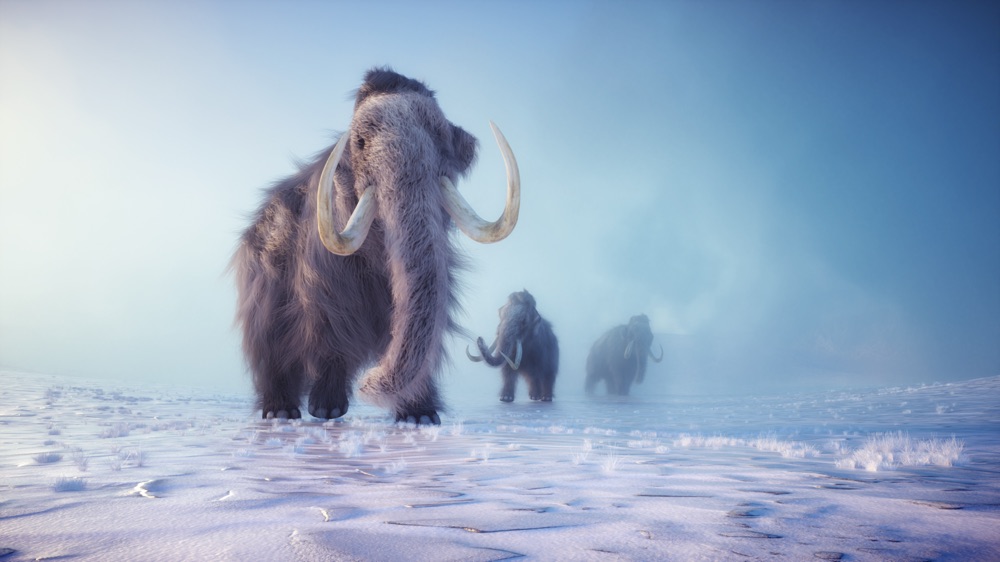Some scientists want to bring back one of the former beasts of Siberia. Is that an ethically responsible thing to do?
Vilde Meinseth Løbersli, master student at the TIK-center, University of Oslo
Imagine walking on the Siberian tundra, the permafrost beneath your feet, the freezing cold temperatures. The only life you would expect to meet is probably the polar bear, birds and maybe some reindeer. There is not a lot of life in the unhospitable arctic.
However, some scientists want to bring back one of the former beasts of Siberia. The woolly mammoth that used to graze the lands some 4,000 years ago before they went extinct.1 Due to the freezing temperatures of the arctic, there has been found remnants of the mammoths in sufficient conditions for DNA to be extracted and potentially utilized.2 With the new CRISPRtechnology scientists are working on bringing them back and a captivating narrative of revival has emerged.

The Northern White Rhino
On the other side of the equator, the northern white rhino once grazed the savannah in Central Africa in great numbers. In the 1960s there was a population of 2,230, but when wars started ravaging in the region, poaching got out of hand, this led to a decline to only 650 individuals in 1970.3
The population dropped further, and when Sudan, the last known male northern white rhino, died in 2018, there was only two left. The mother and daughter duo, Najin and Fatu, represents alone the last northern white rhinos and due to the fear of poaching they are under constant armed surveillance.4 The same technology that could resurrect the mammoth, could also be used to save the rhino, however, bringing back the mammoth gets more funding and more attention.
The northern white rhinos might end with Najin and Fatu, however, eggs have been collected from the two and scientists have managed to create 24 embryos.15
Jurassic Park
De-extinction is not a new concept, both in popular culture and in historical biology. Most of us probably think of the disaster movie Jurassic Park when thinking of bringing back ancient animals.
There have been many attempts to bring back lost species from extinction, from trying to breed backwards, like the project where they tried to bring back the wild ancestor of modern domestic cattle in the 1920s,5 to the only actual case of de-extinction: the Iberian ibex that was cloned from the last individual of the species.6 However, the newborn clone survived for only 10 minutes, but it marked the first case of deextinction and made the Pyrenean ibex the only species to go extinct a second time, 9 years after the first.
It is not until recently that de-extinction has even become a possibility. With new gene editing technology, most notably CRISPR-Cas9, we can add or delete genetic information, making it possible to edit DNA.7
So, by using DNA from mammoths found in the Siberian permafrost, or the last living individuals of the northern white rhino, as a reference one could create individuals of that species through surrogates. One would have to use a relative with similar DNA to the species and edit it to get the one that one seeks to bring back.
Mammoth
In the case of the mammoth, one would have to edit the DNA of an Asian elephant and one would ultimately create a hybrid between the two species. In practice, they are de-extincting genes, not species and the result might be a cold-resistant elephant and not the same mammoth from 4,000 years ago.8
The case is different for the northern white rhino, where we already have good samples of DNA as there are still individuals left, however using CRISPR one could create more genetic diversity through expanding possible sources of genetic material to not only Najin and Fatu, but deceased rhinos whose genetic material was kept. Thus, ensuring that the issue of inbreeding can be minimized.9
The woolly mammoth would even after all that, still not be a woolly mammoth. First is the fact that it would always be somewhat a hybrid animal, but it is also worth noting that woolly mammoths were social animals.10 A mammoth does not raise itself, it used to be a social animal moving in flock, socialized by other mammoths. The northern white rhino is related to the southern white rhino and thus could be socialized that way.12
We could never socialize the animal in the same way, and we cannot give the animal the land area that it would have before it went extinct. Because even if we manage to recreate these animals, their habitats are irrevocably altered.
Ecosystems
The resurrection of extinct species through de-extinction poses intricate challenges to ecosystems. The once-familiar landscapes have transformed significantly since their extinction, making their return like inserting a missing piece into an altered puzzle.
This intervention could have profound consequences on vegetation, wildlife interactions, and resource distribution, potentially altering the entire fabric of the ecosystem as it exists today, ultimately putting existing species in the ecosystem at risk.11
However, bringing back an animal without addressing the factors that led to its extinction could lead to a cycle of suffering or potential re-extinction. The Pyrenean ibex mentioned earlier who only lived for 10 minutes, was a scientific sensation, however the 10 minutes lived was not pleasurable.
De-extinction involves impregnating animals with foreign species and trying to recreate animals without a complete genetic recipe that can be fully understood. When creating a mammoth-hybrid, one guesses the effect the genetic changes have, and the consequences are hard to predict. We might be left with mammoth-hybrids without important cold resistant traits or other deformities.13 This could create a lot of suffering for the animals, and to what ends?
On the savannah in central Africa today, you might still be lucky and see a white rhino, but the chances are that it will be a southern white rhino. While hope is not lost for the northern species, its closely related cousin has taken its place in the ecosystem due to introduction efforts.14 In the meantime, the southern white rhino population, that has been growing up until recent years, are now experiencing a population decline due to poaching.16
There are many reasons to want to bring back animals that have gone extinct. Maybe we feel guilty as humans are the main driver for extinction for a lot of the animals, or maybe this is the result of a morbid curiosity or us just wanting to play God, deciding which species get to exist while we drive others to extinction.
One million species lost
By 2050 one million of the species we know today will go extinct, and there are many known ways for limiting the wave of extinction we are seeing today, from slowing down the global warming, to preserving habitats and end poaching.17 Ecosystems are fragile, and even if reintroduction might be seen as a safety net in the extinction event, it should not be the only solution.
While the idea of resurrecting extinct species captivates our imagination and scientific curiosity, it’s crucial to ensure that these endeavors align with broader conservation goals, serve the greater good of biodiversity preservation, and do not inadvertently compromise the conservation efforts aimed at protecting the species currently facing extinction.
Do we prioritize charismatic megafauna like the woolly mammoth for the allure they bring to scientific exploration, or do we focus on preserving existing species that are on the brink of extinction and are integral to current ecosystems?
It is worth remembering that investing in de-extinction programs could inadvertently divert crucial resources from conservation initiatives designed to protect currently endangered species facing immediate threats.
The technology is there, and ultimately, the question isn’t just about whether we can bring back these species, but whether we should.
This article was originally published in Teknovatøren, the magazine of the students of TIK Centre for Technology, Innovation and Culture, University of Oslo.

Notes
1 Heintz, N., & Liebe Delsett, L. (2022, October 6). Mammut. Retrieved from https://snl.no/mammut
2 Woodward, A. (2021, February 17). Mammoth teeth pulled out of the Siberian permafrost contain the oldest DNA ever found. Retrieved from Business Insider: https:// www.businessinsider.com/mammoth-teeth-siberia-million-year-old-dna-2021-2?r=US&IR=T
3 African and Asian Rhino Specialist Groups (AfRSG). (2023). Northern White Rhino Population. Retrieved from Our World in Data: https://ourworldindata.org/ grapher/northern-white-rhinos
4 Ebersole, R. (2023, September 19). There are two northern white rhinos left on Earth. Can a controversial approach save them? Retrieved from National Geograpic: https:// www.nationalgeographic.com/premium/article/northern-white-rhinoceroses-endangered-deextinction
5 Boissoneault, L. (2017, March 31). When the Nazis Tried to Bring Animals Back From Extinction. Retrieved from Smithsonian Magazine: https://www.smithsonianmag. com/history/when-nazis-tried-bring-animals-back-extinction-180962739/
6 Smith, K. N. (2021, January 23). The Species That Went Extinct Twice. Retrieved from Forbes: https://www. forbes.com/sites/kionasmith/2021/01/23/the-species-that-went-extinct-twice/?sh=66a281fc3312
7 Shah-Neville, W. (2023, March 10). Can CRISPR bring back extinct animals? Retrieved from Labiotech: https:// www.labiotech.eu/in-depth/crispr-de-extinction-tobring-back-animals/
8 Greshko, M. (2021, September 13). Mammoth-elephant hybrids could be created within the decade. Should they be? Retrieved from National Geograpic: https://www. nationalgeographic.com/science/article/mammothelephant-hybrids-could-be-created-within-the-decade-should-they-be
9 inbreeding
10 Pečnerová, P., Díez-del-Molino, D., Dussex, N., Feuerborn, T., Seth, J. von, Plicht, J. van der, Nikolskiy, P., Tikhonov, A., Vartanyan, S., & Dalén, L. (2017). Genome-Based Sexing Provides Clues about Behavior and Social Structure in the Woolly Mammoth. Current Biology, 27(22), 3505- 3510.e3. https://doi.org/10.1016/j.cub.2017.09.064
11 llester. (2016, February 19). De-Extinction, a risky ecological experiment. Retrieved from The Ecological Society of America: https://www.esa.org/esablog/2016/02/19/ de-extinction-a-risky-ecological-experiment/
12 Ebersole, There are two northern white rhinos left on Earth
13 Greshko, Mammoth-elephant hybrids could be created within the decade. Should they be?
14 Green, G. (2021, November 29). White rhinos flown from South Africa to Rwanda in largest single translocation. Retrieved from The Guardian: https://www.theguardian.com/environment/2021/nov/29/white-rhinosflown-from-south-africa-to-rwanda-in-largest-single-translocation
15 FONA. (2023, July 11). BioRescue – Advanced reproductive technologies for saving critically endangered mammals like the northern white rhinoceros. Retrieved from FONA: https://www.fona.de/en/measures/funding-measures/biorescue_copy.php
16 Ol Pejeta Conservancy. (2023). Southern White Rhinos. Retrieved from Ol Pejeta Conservancy: https://www.olpejetaconservancy.org/wildlife/rhinos/southern-white-rhinos/
17 UNEP. (2023, September 5). Five drivers of the nature crisis. Retrieved from UN Environment Program: https://www.unep.org/news-and-stories/story/five-drivers-nature-crisis
Hovedillustrasjon: Artnivora Studio

